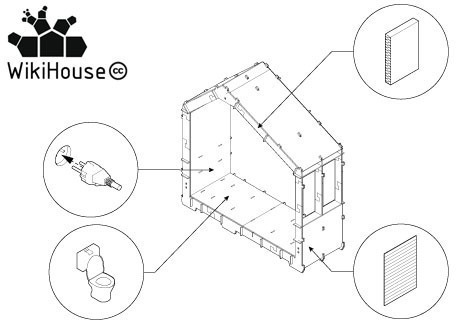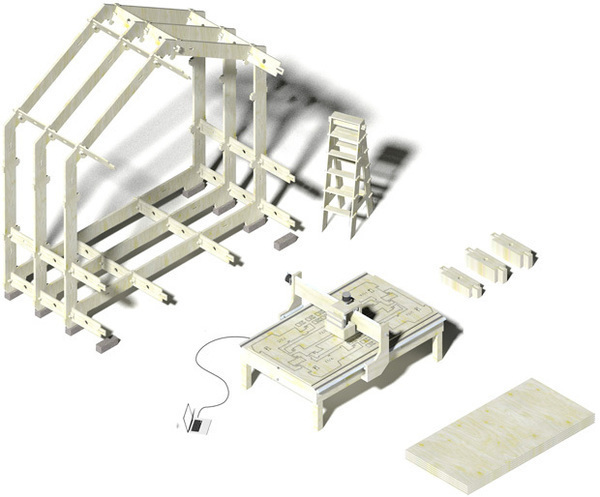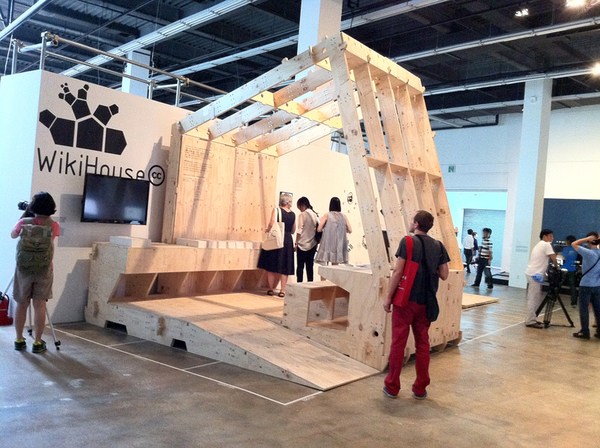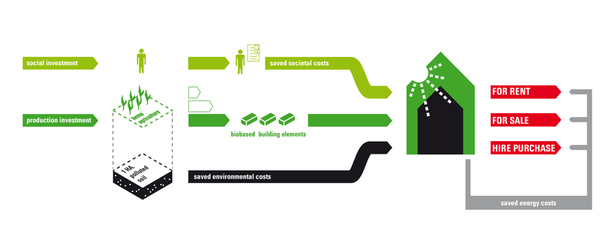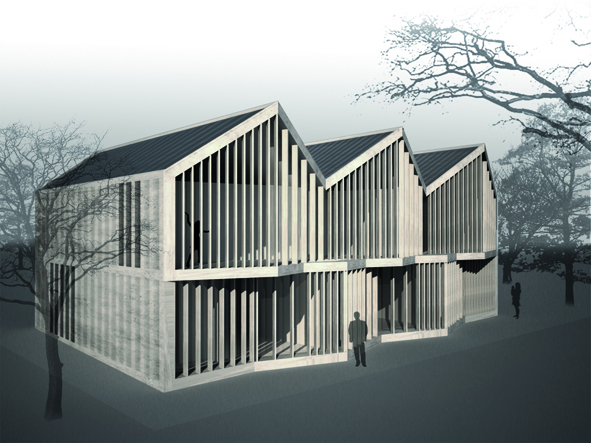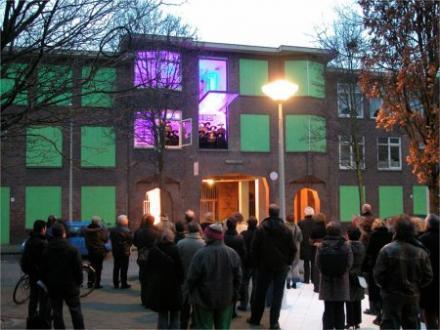Difference between revisions of "Artists and designers are redesigning business"
Rümeysa Önal (talk | contribs) |
|||
| (46 intermediate revisions by 3 users not shown) | |||
| Line 1: | Line 1: | ||
| − | + | {{Article | |
| − | == | + | |Image=wikihouse1.jpg |
| − | An increasing number of designers see the formulation of a business model as a design challenge in itself. | + | |Caption=WikiHouse, an open source house design and construction kit. It's aim is to allow anyone to design, download, and 'print' CNC-milled houses and components, which can be assembled with minimal formal skill or training. |
| − | + | |Summary=An increasing number of designers see the formulation of a business model as a design challenge in itself. As a result of the financial crisis and ongoing social transitions, old certainties have become fluid and new business models are emerging: business models in which the basis of multiple value creation is provided by new and existing cash flows, local entrepreneurship, social capital, open networks, energy transition and new technologies. An increasing number of designers and artists play an important role in the development of these new business models. | |
| − | + | |Article=Author: Iris Schutten | |
| − | As a result of the financial crisis and ongoing social transitions, old certainties have become fluid and new business models are emerging: business models in which the basis of multiple value creation is provided by new and existing cash flows, local entrepreneurship, social capital, open networks, energy transition and new technologies. An increasing number of designers and artists play an important role in the development of these new business models. | ||
| + | === A new design practice === | ||
| − | + | A new design practice is emerging, one which no longer focuses solely on designing a beautiful table, a good building or a pleasant neighbourhood, but also considers the processes in which these designs were realised as a design challenge in itself. An increasing number of designers share their designs according to open source principles, and allow consumers to influence the creation process by participating in its development, financing or fabrication. For example, initiatives such as Space&matter's 'CRWDBLDNG', 'Blauwhoed' and 'Open Development', and the project 'Wikihouse' by strategy office 00://. We are increasingly witnessing the emergence of new forms of ownership; local initiatives are claiming vacant buildings, people can lease jeans instead of buying them, and small groups of individuals are setting up neighbourhood energy cooperatives. Additionally, the circular economy is increasingly perceived as a way out of the current ecological and economic crises. For example, projects such as Superuse Studios' 'Villa Welpeloo', Duzan Doepel's 'Biobased Retrofit House', and 'De Ceuvel' by Metabolic Lab and Space&matter. In such projects, local issues (waste products, energy, local communities and expertise) become valuable assets. In all these projects, the designers have not only designed the physical final object, but also contributed to designing the relevant business model, which in turn plays a role in defining the physical manifestation of the design. In other words, this type of participation in the design of the context opens up new possibilities for the physical design. | |
| − | + | [[File:wikihouse2.jpg|WikiHouse Model]] | |
| − | [[File: | ||
| − | |||
| + | [[File:wikihouse3.jpg|The first non-prototype WikiHouse was part of the Gwangju Design Biennale 2011 in South Korea.]] | ||
=== Social Practices === | === Social Practices === | ||
| − | Designers whose work practice is based on this type of perspective regarding the scope of their professional field, are active in what can be considered | + | Designers whose work practice is based on this type of perspective regarding the scope of their professional field, are active in what can be considered as 'social practices'. Social practices are gaining in popularity these days, with an increasing number of projects, publications and conferences on the subject. For example, two books presented recently at the Dutch Design Week 2014: 'Social Design for Wicked Problems' and 'Looks Good, Feels Good, Is Good', as well as conferences such as 'What Design Can Do' and 'Rethink'. This development seems to pick up on work done ten years ago by artists such as Jeanne van Heeswijk and Sabrina Lindemann, for example the project 'De Strip' in Vlaardingen and 'OpTrek Transvaal' in The Hague. |
| − | |||
| − | |||
| + | The resurgence of social practices in the contemporary discourse of art, design and education should come as no surprise: it is a reaction to a society in a state of transition. Though our society has always been changing, currently these changes seem to be taking place faster, more intensively and more broadly than what we had previously been accustomed to. Many believe that the future will not be merely an extrapolation of the present and the familiar, but that there are systemic shifts taking place simultaneously on several levels, in various disciplines and on different scales. Whether this change of system turns out to be relatively large or small, an important characteristic of social practitioners is that they explicitly choose to research and critically examine such change, and to play a role in its design. Competent social designers and social artists can position themselves in an original way as game changers. It is not surprising that many designers are currently active in this field. On one hand, the time seems ripe to work on the development of alternative business models; the old ways of doing business no longer work or have proven undesirable. On the other hand, tools from the creative disciplines - such as design thinking and systemic analysis - help make it possible to design new business models. | ||
=== Change of system === | === Change of system === | ||
| Line 25: | Line 23: | ||
Though some believe that once we have made it through the current economic crisis, we will go back to the way things were before, others argue that the world of tomorrow will be very different from that of yesterday. The Russian Economist Nikolai Kondratiev has convincingly argued that crises are always preceded by social revolutions, for example the industrial revolution or the introduction of the automobile. What all these crises have in common is that the world before and after the crisis is completely different; with different organisational structures, new business models, and new players in charge. If we consider the current crisis a similar tipping point, this can become an opportunity for re-thinking the creative disciplines as well as existing business models. | Though some believe that once we have made it through the current economic crisis, we will go back to the way things were before, others argue that the world of tomorrow will be very different from that of yesterday. The Russian Economist Nikolai Kondratiev has convincingly argued that crises are always preceded by social revolutions, for example the industrial revolution or the introduction of the automobile. What all these crises have in common is that the world before and after the crisis is completely different; with different organisational structures, new business models, and new players in charge. If we consider the current crisis a similar tipping point, this can become an opportunity for re-thinking the creative disciplines as well as existing business models. | ||
| − | During the past century, citizens had gradually become dependent on an economic structure which was increasingly uniform and large-scale, and regulated according to top-down models. New generations, on the other hand, seem to increasingly make use of more horizontal structures, while operating through various (invisible) networks and expressing their social and political engagement through quick and flexible structures. At the same time, we can also observe a movement in the opposite direction: ever-increasing consumption, individualisation, increase of scale, and clustering of power in the hands of a smaller number of larger multinationals; as well as exhaustion of natural resources, peak oil, plastic soup, the exploitation of people, animals and the planet, and ever-increasing income inequality. Another important factor is large-scale migration streams, with the associated refugee dramas and xenophobia. Furthermore we are faced with new challenges in the fields of ageing demographics, social care and healthcare, economic and demographic shrinkage, and food and water shortages. | + | During the past century, citizens had gradually become dependent on an economic structure which was increasingly uniform and large-scale, and regulated according to top-down models. New generations, on the other hand, seem to increasingly make use of more horizontal structures, while operating through various (invisible) networks and expressing their social and political engagement through quick and flexible structures. At the same time, we can also observe a movement in the opposite direction: ever-increasing consumption, individualisation, increase of scale, and clustering of power in the hands of a smaller number of larger multinationals; as well as exhaustion of natural resources, peak oil, plastic soup, the exploitation of people, animals and the planet, and ever-increasing income inequality. Another important factor is large-scale migration streams, with the associated refugee dramas and xenophobia. Furthermore, we are faced with new challenges in the fields of ageing demographics, social care and healthcare, economic and demographic shrinkage, and food and water shortages. |
| − | Sailing on the choppy waves of such complex developments, various thinkers and designers are proposing a change of system; a switch from large-scale to small-scale structures, from large initial investments to more gradual cash flow plannings, from organisations with a few professionals in charge to practices with a large number of players, from final situation to initial situation, from trust in standard methods to experimentation with new ones, from financial gain to multiple value creation. | + | Sailing on the choppy waves of such complex developments, various thinkers and designers are proposing a change of system; a switch from large-scale to small-scale structures, from large initial investments to more gradual cash flow plannings, from organisations with a few professionals in charge to practices with a large number of players, from final situation to initial situation, from trust in standard methods to experimentation with new ones, from financial gain to multiple value creation. |
| + | [[File:Retrofit_biobased_businesscase.jpg|Biobased Retrofit House by Doepel Strijkers Architecten]] | ||
| − | + | [[File:ActiveReUseHouse.jpg|Active Reuse House by Doepel Strijkers Architecten]] | |
| − | |||
| − | + | === Redesigning Business === | |
| − | + | Mapping, shifting the perspective, reframing and the ability to bring various stakeholders together are all skills which are especially relevant in the context of a change of system. Social practices can play a valuable role here. Two constantly recurring aspects in social practices are: the introduction of the time factor in the development process, and the focus on the existing situation – the people, networks, buildings, knowledge, expertise, materials and needs that are already present. In social practices, designers connect these local forces in such a way that allows for new perspectives, which are given the time to develop step by step, so that new visions on ownership and capital can emerge. | |
| + | Obviously, this is not always a simple process. A change of system always requires a great deal of patience, daring and perseverance, as well as improvisational ability, systems analysis and change management. As a consequence, the field of art and design education is also changing. Since 2011, the Royal Academy of Art in The Hague offers the new master programme 'INSIDE'; the Willem de Kooning Academy in Rotterdam offers 'Social Practices' as one of its three new interdisciplinary graduation profiles; and the Design Academy in Eindhoven offers the master programme 'Social Design'. In other countries, this change is also acknowledged, for example in Baltimore (Center for Social Design) and at Budapest's Moholy-Nagy University of Art and Design(EcoLab). All these programmes are based on the idea that interdisciplinarity is now a reality, and change management has become a necessity in order to supersede existing practices. | ||
| − | + | [[File:interact.jpg|Interact, In Situ architecten for Mobiel Projektburo OpTrek Transvaal, Den Haag]] | |
| − | + | There is no blueprint for how to proceed and that is a good thing too. However, a specific attitude can clearly be observed: an attitude which links ideals to decisiveness and imagination, with and in the here and now, and without becoming preachy or patronising. This is the attitude that will bring welcome change to part of the world of art and design. | |
| − | + | ''Iris Schutten, 2014'' | |
| − | + | ''Iris Schutten coordinates the Social Practices at the Willem de Kooning Academy (University of Applied Sciences, Rotterdam) and is architect/writer at Studio Iris Schutten.'' | |
| − | [[Category: | + | [[Category:education]] |
| − | [[Category: | + | [[Category:bottom-up]] |
| − | [[Category: | + | [[Category:economy]] |
| − | [[Category: | + | [[Category:reframing]] |
| − | [[Category: | + | [[Category:transformation]] |
| + | [[Category:systems]] | ||
| + | [[Category:discourse]] | ||
| + | [[Category:sustainability]] | ||
| + | }} | ||
| + | {{Category selector}} | ||
| + | {{Articles more}} | ||
Latest revision as of 20:28, 23 October 2018
Author: Iris Schutten
A new design practice
A new design practice is emerging, one which no longer focuses solely on designing a beautiful table, a good building or a pleasant neighbourhood, but also considers the processes in which these designs were realised as a design challenge in itself. An increasing number of designers share their designs according to open source principles, and allow consumers to influence the creation process by participating in its development, financing or fabrication. For example, initiatives such as Space&matter's 'CRWDBLDNG', 'Blauwhoed' and 'Open Development', and the project 'Wikihouse' by strategy office 00://. We are increasingly witnessing the emergence of new forms of ownership; local initiatives are claiming vacant buildings, people can lease jeans instead of buying them, and small groups of individuals are setting up neighbourhood energy cooperatives. Additionally, the circular economy is increasingly perceived as a way out of the current ecological and economic crises. For example, projects such as Superuse Studios' 'Villa Welpeloo', Duzan Doepel's 'Biobased Retrofit House', and 'De Ceuvel' by Metabolic Lab and Space&matter. In such projects, local issues (waste products, energy, local communities and expertise) become valuable assets. In all these projects, the designers have not only designed the physical final object, but also contributed to designing the relevant business model, which in turn plays a role in defining the physical manifestation of the design. In other words, this type of participation in the design of the context opens up new possibilities for the physical design.
Social Practices
Designers whose work practice is based on this type of perspective regarding the scope of their professional field, are active in what can be considered as 'social practices'. Social practices are gaining in popularity these days, with an increasing number of projects, publications and conferences on the subject. For example, two books presented recently at the Dutch Design Week 2014: 'Social Design for Wicked Problems' and 'Looks Good, Feels Good, Is Good', as well as conferences such as 'What Design Can Do' and 'Rethink'. This development seems to pick up on work done ten years ago by artists such as Jeanne van Heeswijk and Sabrina Lindemann, for example the project 'De Strip' in Vlaardingen and 'OpTrek Transvaal' in The Hague.
The resurgence of social practices in the contemporary discourse of art, design and education should come as no surprise: it is a reaction to a society in a state of transition. Though our society has always been changing, currently these changes seem to be taking place faster, more intensively and more broadly than what we had previously been accustomed to. Many believe that the future will not be merely an extrapolation of the present and the familiar, but that there are systemic shifts taking place simultaneously on several levels, in various disciplines and on different scales. Whether this change of system turns out to be relatively large or small, an important characteristic of social practitioners is that they explicitly choose to research and critically examine such change, and to play a role in its design. Competent social designers and social artists can position themselves in an original way as game changers. It is not surprising that many designers are currently active in this field. On one hand, the time seems ripe to work on the development of alternative business models; the old ways of doing business no longer work or have proven undesirable. On the other hand, tools from the creative disciplines - such as design thinking and systemic analysis - help make it possible to design new business models.
Change of system
Though some believe that once we have made it through the current economic crisis, we will go back to the way things were before, others argue that the world of tomorrow will be very different from that of yesterday. The Russian Economist Nikolai Kondratiev has convincingly argued that crises are always preceded by social revolutions, for example the industrial revolution or the introduction of the automobile. What all these crises have in common is that the world before and after the crisis is completely different; with different organisational structures, new business models, and new players in charge. If we consider the current crisis a similar tipping point, this can become an opportunity for re-thinking the creative disciplines as well as existing business models.
During the past century, citizens had gradually become dependent on an economic structure which was increasingly uniform and large-scale, and regulated according to top-down models. New generations, on the other hand, seem to increasingly make use of more horizontal structures, while operating through various (invisible) networks and expressing their social and political engagement through quick and flexible structures. At the same time, we can also observe a movement in the opposite direction: ever-increasing consumption, individualisation, increase of scale, and clustering of power in the hands of a smaller number of larger multinationals; as well as exhaustion of natural resources, peak oil, plastic soup, the exploitation of people, animals and the planet, and ever-increasing income inequality. Another important factor is large-scale migration streams, with the associated refugee dramas and xenophobia. Furthermore, we are faced with new challenges in the fields of ageing demographics, social care and healthcare, economic and demographic shrinkage, and food and water shortages.
Sailing on the choppy waves of such complex developments, various thinkers and designers are proposing a change of system; a switch from large-scale to small-scale structures, from large initial investments to more gradual cash flow plannings, from organisations with a few professionals in charge to practices with a large number of players, from final situation to initial situation, from trust in standard methods to experimentation with new ones, from financial gain to multiple value creation.
Redesigning Business
Mapping, shifting the perspective, reframing and the ability to bring various stakeholders together are all skills which are especially relevant in the context of a change of system. Social practices can play a valuable role here. Two constantly recurring aspects in social practices are: the introduction of the time factor in the development process, and the focus on the existing situation – the people, networks, buildings, knowledge, expertise, materials and needs that are already present. In social practices, designers connect these local forces in such a way that allows for new perspectives, which are given the time to develop step by step, so that new visions on ownership and capital can emerge.
Obviously, this is not always a simple process. A change of system always requires a great deal of patience, daring and perseverance, as well as improvisational ability, systems analysis and change management. As a consequence, the field of art and design education is also changing. Since 2011, the Royal Academy of Art in The Hague offers the new master programme 'INSIDE'; the Willem de Kooning Academy in Rotterdam offers 'Social Practices' as one of its three new interdisciplinary graduation profiles; and the Design Academy in Eindhoven offers the master programme 'Social Design'. In other countries, this change is also acknowledged, for example in Baltimore (Center for Social Design) and at Budapest's Moholy-Nagy University of Art and Design(EcoLab). All these programmes are based on the idea that interdisciplinarity is now a reality, and change management has become a necessity in order to supersede existing practices.
There is no blueprint for how to proceed and that is a good thing too. However, a specific attitude can clearly be observed: an attitude which links ideals to decisiveness and imagination, with and in the here and now, and without becoming preachy or patronising. This is the attitude that will bring welcome change to part of the world of art and design.
Iris Schutten, 2014
Iris Schutten coordinates the Social Practices at the Willem de Kooning Academy (University of Applied Sciences, Rotterdam) and is architect/writer at Studio Iris Schutten.Links
CONTRIBUTE
Feel free to contribute to Beyond Social.
